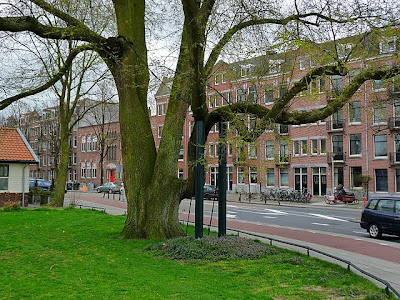 |
| A huge tree with heavy branches, on the corner of Zeeburgerdijk and Panamalaan in Indische Buurt / Amsterdam East; early spring 2013. (c) FotoDutch |
Scientists of Flemish Institute for for Technological Research have been published on the journal Environmental Pollution an article concerning the role of trees on the improvement of air quality in urban environment. Authors are: Peter E.J. Vos, Bino Maiheu, Jean Vankerkom, Stijn Janssen. Here the abstract.
Vegetation is often quoted as an effective measure to mitigate urban air quality problems. In this work we demonstrate by the use of computer models that the air quality effect of urban vegetation is more complex than implied by such general assumptions. By modelling a variety of real-life examples we show that roadside urban vegetation rather leads to increased pollutant concentrations than it improves the air quality, at least locally. This can be explained by the fact that trees and other types of vegetation reduce the ventilation that is responsible for diluting the traffic emitted pollutants. This aerodynamic effect is shown to be much stronger than the pollutant removal capacity of vegetation. Although the modelling results may be subject to a certain level of uncertainty, our results strongly indicate that the use of urban vegetation for alleviating a local air pollution hotspot is not expected to be a viable solution.
Follow this link for more information about this article: Environmental Pollution Volume 183, December 2013, Pages 113–122
Affiliations:
Environmental Modelling Unit, Flemish Institute for Technological Research (VITO), Boeretang 200, 2400 Mol, Belgium
Peter E.J. Vos, Bino Maiheu, Jean Vankerkom, Stijn Janssen
No comments:
Post a Comment